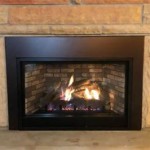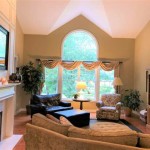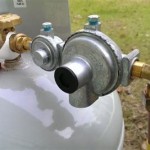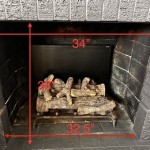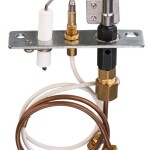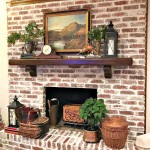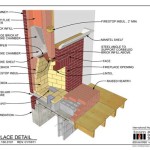Faux Rock Fireplace: A Cost-Effective and Versatile Home Feature
A faux rock fireplace provides homeowners with an aesthetically pleasing alternative to traditional masonry fireplaces. This option offers the visual appeal of natural stone without the associated costs, weight, and structural requirements. Constructed using manufactured materials that mimic the appearance of various rock types, faux rock fireplaces are gaining popularity for their adaptability and ease of installation.
The core of a faux rock fireplace typically consists of a framework constructed from wood or metal studs. This framework forms the basic shape of the fireplace and provides support for the faux rock panels or individual stones. Insulation is often incorporated into the framework to improve energy efficiency and fire safety. The next layer involves attaching a cement backer board or a similar durable material to the framework. This backer board provides a stable and moisture-resistant surface for adhering the faux rock.
Faux rock materials are available in a wide array of styles, colors, and textures. Homeowners can choose from options that replicate fieldstone, river rock, stacked stone, and even ledgestone. The individual stones or panels are carefully fitted and adhered to the backer board using mortar or construction adhesive. Grouting is commonly used to fill the gaps between the stones, creating a more realistic and visually appealing finish. Careful attention is paid to the patterns and arrangement of the stones to achieve a natural-looking effect.
Faux rock fireplaces can be integrated with various types of fireboxes, including gas, electric, and even traditional wood-burning units, although code compliance and safety regulations must be strictly adhered to when incorporating a wood-burning firebox. The overall design can be customized to fit the architectural style of the home, ranging from rustic and traditional to modern and contemporary.
Key Advantages of Faux Rock Fireplaces
One of the most significant advantages of a faux rock fireplace is its cost-effectiveness. The materials used are significantly less expensive than natural stone, and the installation process is typically faster and less labor-intensive, resulting in lower overall project costs. The lighter weight of faux rock also reduces the need for extensive structural support, further contributing to cost savings. This makes it a feasible option for homeowners who desire the look of natural stone but are constrained by budget.
Another benefit is the ease of installation. Unlike traditional stone fireplaces that require specialized skills and equipment, faux rock fireplaces can often be installed by experienced DIYers or general contractors. The modular nature of many faux rock products, such as pre-formed panels, simplifies the installation process, reducing the time and effort required. This characteristic makes faux rock a practical choice for renovation projects where minimizing disruption is a priority.
Furthermore, faux rock fireplaces offer greater design flexibility compared to natural stone. The manufactured materials can be molded into various shapes and sizes, allowing for customized designs that complement a wide range of interior styles. Homeowners can choose from a vast selection of colors, textures, and patterns to create a fireplace that perfectly matches their aesthetic preferences. The consistency in color and texture offered by manufactured stone also ensures a uniform and predictable appearance, which can be an advantage for those seeking a specific look.
Material Composition and Durability
Faux rock is typically manufactured from a blend of concrete, aggregates, and pigments. Some manufacturers incorporate lightweight materials to further reduce the weight of the finished product. The specific composition can vary depending on the manufacturer and the intended application, but the goal is always to create a material that is durable, weather-resistant, and visually appealing.
The durability of faux rock depends on the quality of the materials used and the manufacturing process. High-quality faux rock products are designed to withstand the elements and resist fading, cracking, and crumbling. However, it is important to choose products from reputable manufacturers and to follow the installation instructions carefully to ensure long-lasting performance. Regular cleaning and maintenance can also help to preserve the appearance and integrity of the faux rock over time.
While faux rock is generally durable, it is not as resistant to impact as natural stone. Therefore, it is important to protect the fireplace from accidental damage. If a faux rock stone or panel is damaged, it can usually be repaired or replaced relatively easily. The availability of replacement stones or panels is another advantage of using manufactured materials.
Design Considerations for Faux Rock Fireplaces
When designing a faux rock fireplace, it is essential to consider the overall style of the home and the existing décor. The size and shape of the fireplace should be proportionate to the room in which it is located. A large, imposing fireplace may overwhelm a small room, while a small, understated fireplace may get lost in a large, open space. The color and texture of the faux rock should also complement the surrounding furnishings and architectural elements.
The placement of the fireplace is another important consideration. Fireplaces are often focal points in a room, so they should be positioned in a location that is both visually appealing and functional. It is also important to consider the location of windows, doors, and other architectural features when planning the placement of the fireplace. Careful planning can help to create a cohesive and harmonious design.
In addition to the faux rock itself, other design elements can be incorporated to enhance the appearance of the fireplace. A mantel can provide a decorative shelf for displaying artwork, photos, or other decorative objects. A hearth can add visual interest and texture to the base of the fireplace. Lighting can also be used to highlight the texture and color of the faux rock, creating a warm and inviting atmosphere.
Installation Process: A Step-by-Step Overview
The installation of a faux rock fireplace typically involves several key steps. The first step is to construct the framework for the fireplace using wood or metal studs. The framework should be sturdy and properly aligned to ensure that the finished fireplace is structurally sound.
The next step is to attach a cement backer board or similar durable material to the framework. The backer board provides a stable and moisture-resistant surface for adhering the faux rock. The backer board should be securely fastened to the framework using screws or nails.
Once the backer board is in place, the faux rock can be installed. The individual stones or panels are carefully fitted and adhered to the backer board using mortar or construction adhesive. It is important to follow the manufacturer's instructions carefully when applying the adhesive.
After the faux rock is installed, the gaps between the stones are typically filled with grout. The grout should be applied evenly and smoothly to create a seamless and natural-looking finish. The grout should be allowed to dry completely before cleaning off any excess material.
Finally, any finishing touches, such as installing a mantel or hearth, can be added to complete the fireplace. The entire installation process should be inspected to ensure that it meets all building codes and safety regulations.
Maintenance and Care
Faux rock fireplaces require minimal maintenance compared to natural stone fireplaces. Regular dusting or vacuuming can help to remove dirt and debris from the surface of the faux rock. If the faux rock becomes stained, it can usually be cleaned with a mild soap and water solution.
It is important to avoid using harsh chemicals or abrasive cleaners, as these can damage the surface of the faux rock. Pressure washing is generally not recommended, as it can erode the grout and damage the stones. Minor cracks or chips can usually be repaired with a patching compound that is specifically designed for use on faux rock.
Periodic inspections can help to identify any potential problems early on. Look for signs of cracking, crumbling, or water damage. Addressing these issues promptly can help to prevent further damage and extend the lifespan of the faux rock fireplace.

Thin Stone Veneers Make A Fireplace Update Easy

Natural Stacked Stone Veneer Fireplace Ideas

Stone Fireplace Design And Remodel

Jerre S Faux Stone Fireplace Surround Genstone

Stone Veneer Fireplace Ideas That Will Warm Up Your Home Ply Gem

12 Stacked Stone Fireplace Ideas For Optimal Coziness

11 Stone Veneer Fireplace Surround Design Trends Where To Buy

Faux Stone For Fireplaces

Stone Fireplace Makeover Part 2 Faux Whitewash Organized Ish

How To Build An Outdoor Stacked Stone Fireplace
Related Posts

